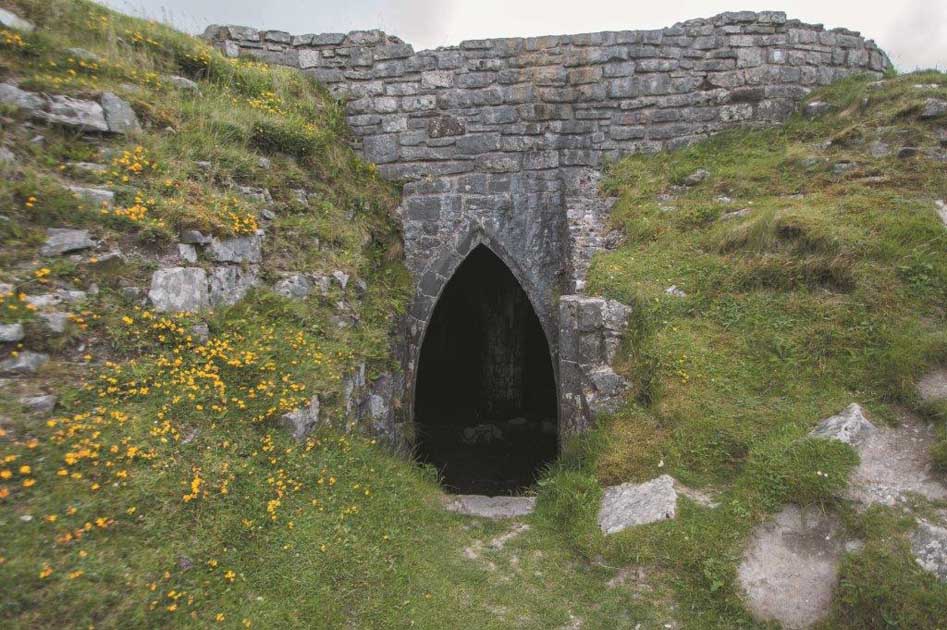Morlais Castle

Morlais Castle Details
Morlais Castle, ruins and earthworks of massive unfinished C13 castle of Gilbert de Clare
- Closest To: Trefechan, Merthyr Tydfil, Pontstycill
- Access: Free Public Access
- Grid Reference: SO049096
Morlais Castle is a huge masonry castle built within the defences of an Iron Age hillfort overlooking the valley of the Taf Fechan, and the site of the earlier motte of Cae Burdydd the other side of the river. It is accessible on foot, but is a stiff climb from the car park by the river, otherwise access can be sought from the Morlais Castle Golf Club.
The castle was built for Gilbert de Clare (II), Earl of Gloucester, in the context of a dispute with his equally proud but less wealthy neighbour Humphrey de Bohun, Earl of Hereford. Clare had annexed the upland commotes of Senghenydd, and his castle was founded c1288, intended to demonstrate his lordship over the local Welsh much as his castle of Caerphilly had over the lower commotes. However, Bohun insisted that it encroached upon his lordship of Brecon, and these two powerful lords of the Welsh March embarked upon a private war against the express wishes of King Edward I. It was captured by the Welsh in their revolt of 1294/95, and Edward significantly did not punish the offenders who claimed they were rebelling against Clare only, leading to the conclusion that the king was not displeased by the capture.
The footprint of the castle is roughly rectangular. The outer (south) ward is protected by an earth bank that encloses a roughly rectangular area, but this terminates at the steep western cliff, and has probably been damaged by quarrying in this area. To the north is a massive rock-cut ditch, with a causeway crossing it by the western precipice, and it is notable that the bank extends to the base of the large slope to the north, crowned by the masonry of the Outer Ward and a largely buried round keep. It is easy to be tempted to consider this similar to a motte and bailey. A second causeway crosses the rock cut ditch on the east side, where a ramp then leads up to a break in the curtain wall that was the main gateway, and the ditch is then unfinished at the northern end, although functional as a defence throughout. A D-shaped tower on the northern side overlooks the gateway, and a second is midway between the gate tower and the southern keep; a round tower to the west of the keep overlooks the precipice, and then it is postulated that another round or D-shaped tower marked the point where the curtain wall actually stood at the edge of the drop. A curtain wall then ran across from the gate tower to the west curtain, dividing the castle into two courtyards. Traces of two large buildings can be seen against the east curtain, another against the west, and a deep cistern has been cut into the rock in front of the opening in the medial wall. In the middle of this medial wall was a projecting D-shaped tower, and the gate between the two courtyards was between this tower and the eastern wall. A great hall complex then lay beyond, where the east and west curtains formed the remaining sides of a triangle, with a second massive round keep at the northern end of the castle.
Much of the masonry lies buried beneath the turf and is collapsed, but the southern keep has been concreted over at the top, permitting the spectacular rib-vaulted basement to be accessed safely. One cannot but be impressed by the scale of this project. By the time Earl Gilbert was summoned to the king’s court in 1291, the castle had been perhaps three years in the building, and Gilbert declined to attend the court, continuing to raid Bohun’s lands. By the end of the year Bohun had lost faith in the king, and mounted retaliatory raids, leading to both being imprisoned and having their lands confiscated, although they were able to obtain their lands back and their freedom on payment of a fine. When the Welsh rebelled in 1294, the leader in Glamorgan was Morgan ap Maredudd, who had been a royal agent for years. In October Morlais was taken, and Earl Gilbert forced to retreat from the area. It was not until June 1295 that Morgan was escorted to the king’s presence with 700 followers and Edward accepted their homage – against Clare’s wishes. Earl Gilbert died in December, and it is not believed that further works took place at the castle. Although it is believed that the castle was never completed, it is worth noting that the 1741 view of the Buck brothers shows that it was completed to a substantial height, but this had fallen by the end of the century. Morlais may not have been completed, but it is certain that considerably more stood in 1294 than might be believed.
Become a supporter of my work to access a more detailed history